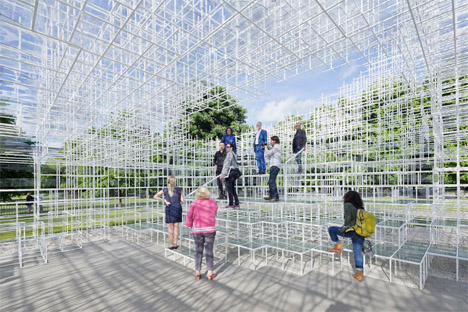[ By Steph in Architecture & Public & Institutional. ]

Before a new form of architecture can be executed on a large scale, it has to be demonstrated through smaller structures, making temporary pavilions an ideal way to experiment. These 14 pavilions represent novel and often radical designs and construction methods, from carbon fiber structures woven by robots to living architecture made by silk worms.
Evolving Pavilion Made by Silk Worms


Nature and technology work together on a pavilion that grows and transforms like a living organism. The Silk Pavilion by the MIT Media Lab features a basis of silk threads made by a CNC machine, which grows into a cloud-like structure with the addition of natural netting from dozens of silk worms. The worms were essentially deployed as a biological ‘printer’ to create the secondary structure on top of the geometric base. If the sculpture were to remain in place indefinitely, it could reproduce on its own, with new generations of silkworms constructing up to 250 additional pavilions.
Serpentine Pavilion by Sou Fujimoto


This 2013 Serpentine Gallery Pavilion by Sou Fujimoto is a contradiction in form, translucent yet solid. 20mm pipes are arrange din a lattice form to create a cloud-like appearance, inviting visitors to enter and climb the framework.
Abstracted & Faceted Bloomberg Pavilion


Looking like an oversized piece of paper origami, the Bloomberg Pavilion by Akihasa Hirata is actually inspired by a tree and constructed from pleated metal. “I wondered what would happen if the walls were to keep growing upwards and present an uneven surface like ‘pleats’. Pleats resemble a tree in the way that they spread out and capture the sun and I felt that they would produce a bright, impressive exterior. I also thought that the space beneath this surface would present a relaxed atmosphere, similar to that of tree shade that would be an ideal quality for an exhibition space.”
Carbon Fiber Pavilion Based on Beetle Shells


This incredible carbon fiber pavilion inspired by the lightweight shell encasing the wings and abdomen of a beetle was woven by a robot. Installed at the University of Stuttgart, the ICD/ITKE Research Paviliion 2013-14 was fabricated using a custom-built system of robotics used to create a series of modular fiber-composite components. Says team member Marshall Prado, “”It offers not only a unique architectural expression and spatial experience, it is also extremely lightweight and resource efficient.”
Next Page – Click Below to Read More:
Experimental Architecture 14 Boundary Pushing Pavilions




[ By Steph in Architecture & Public & Institutional. ]
[ WebUrbanist | Archives | Galleries | Privacy | TOS ]



You must be logged in to post a comment.